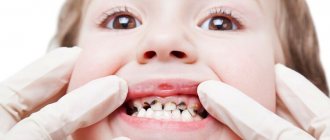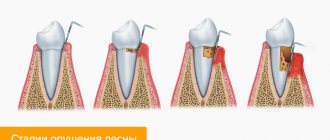Caries... “Hole” in a tooth, “hollow”, “leaky tooth”. Caries is one of the most common diseases on the planet, affecting all segments of the population and all age groups. There is no clear opinion why caries is the most common pathology and the reasons for its occurrence in medical circles. But the fact that translated from Latin the word “caries” means “rotting” will not leave anyone indifferent if the process of decay affects one’s own teeth.
Of course, the process of decay and destruction must be stopped, eliminated, and, if possible, the teeth affected by caries must be restored.
Definition of the concept in dentistry
Deep caries is the last stage of the carious process occurring in the tooth, which is characterized by extensive damage not only to hard tissues, but also to the deep layers of dentin. In general, the concept of “deep caries” reflects the depth of the lesion.
Caries can be:
- primary - a consequence of untreated secondary caries;
- secondary (recurrent) - the occurrence of a carious process under a filling in a previously treated tooth.
Based on the sensation of pain and clinical examination, the disease is divided into 3 forms:
- Acute form. It is determined by the narrow entrance opening of the carious cavity and the wide base (during examination), as well as by descriptions of the patient’s sensations - reaction to food temperature and chemical irritants.
- Chronic form. It is characterized by a wide (funnel-shaped) inlet and a narrow base. The patient feels pain when the “hollow” is clogged with food and during examination with a probe by the dentist.
- Deep cervical caries. It is characterized by the development of demineralization of enamel tissue and the carious process in the cervical area of the tooth (near the gums).
According to the clinical course, caries is also divided into several forms:
- compensated,
- subcompensated,
- decompensated.
What can cause caries
There are several suggestions, for example, that tooth decay is transmitted genetically or that lack of hygiene contributes to the development of the disease. All this is true, but does not give the complete picture.
Where a person lives can also influence the occurrence of caries, namely the quality of water in that area.
Nutrition plays an important role in the prevention of caries. There are scientific studies confirming that eating fresh vegetables, greens and foods rich in proteins helps prevent tooth decay. That is, those people who like to chew raw carrots are less susceptible to dental diseases. That's why you should eat meat and a lot of raw vegetables - this is not only smart advice from nutritionists, but sound prevention in the fight against the development of dental caries.
Diagnostics
To make a diagnosis, diagnostics are carried out, which include:
- external inspection using a mirror;
- instrumental examination using a probe;
- voicing symptoms (complaints) by the patient;
- thermal diagnostics (checking the reaction to cold and hot);
- electroodontic diagnostics (testing the reaction to exposure to current);
- radiography (performed if the presence of secondary deep caries is suspected or to exclude it).
If upon examination significant damage (destruction) of the tooth crown is detected, expressed by the presence of a deep carious cavity and accompanied by pain during probing, then this confirms the presence of deep caries in the patient.
In the acute form, the carious cavity is filled with light, softened dentin. In chronic deep caries, the walls and bottom of the cavity are filled with a layer of dense pigmented dentin (from brown to black). Percussion of the tooth is not accompanied by pain.
Malocclusion and pain in the spine
An unreplaced tooth violates occlusion - the correct physiological closure of the remaining teeth of the upper and lower jaw. Not immediately, but after a few years this will lead to the appearance of painful sensations - first in the temporomandibular joint, and then in the cervical spine, and, as a result, to regular headaches.
Our body is truly one whole. Therefore, a lower jaw displaced back or upper teeth protruding forward can cause the appearance of associated skeletal problems - from flat feet to scoliosis. This is well known to dentists and patients of orthodontic centers.
When a person finally wants to do implantation and install a denture on an artificial root, he will first have to correct the bite with braces or aligners.
What are the differences from other forms of the disease?
Deep caries is very similar to some forms of the disease, but there are still visible and invisible differences.
Difference from pulpitis
Pulpitis is a complication of advanced caries. The forms of the disease can be distinguished from each other by their characteristic symptoms:
- Defeat. With pulpitis, the nerve is affected; with caries, the nerve remains unharmed.
- Feelings of pain. With pulpitis, pain can occur spontaneously, even without exposure to irritants on the tooth. With caries, pain disappears along with the disappearance of irritants.
- Night sleep. With pulpitis, sleep can be disturbed due to severe pain; with caries, the tooth does not hurt at night.
Difference from average caries
The similarity between the two forms of the disease is that the patient in both forms feels pain from cold, sour or sweet foods. However, with average caries they go away within 1-2 minutes, with deep caries they last longer.
Medium caries is characterized by the fact that in this form the carious lesion does not affect the tooth pulp and does not cause inflammation of the nerve, as in deep caries.
Why do we most often recommend removing teeth with periodontitis?
Our natural teeth are a hotbed of inflammatory processes. They have a porous structure, so it is on them that all microbes, which have a destructive effect on periodontal tissue, first settle. If implants with an active surface are placed next to such teeth, even the most resistant ones, which contain chemical elements that promote the healing of bone cells (such as SLActive® from Straumann and TiUnit® or TiUltra® from Nobel Biocare), they will still are unable to cope with a massive attack from all sides and bone tissue atrophy. That is, by preserving our natural teeth, we risk losing all the results of implantation.
So if there are only a few teeth left, they are destroyed and affected by diseases, then there is no point in preserving them - it is much easier to carry out removal with simultaneous replacement with implants, after which it will be enough to carry out regular oral hygiene (on your own and with a dental hygienist) and actually forget about dental problems forever. After all, if there are no teeth, there is no inflammation.
We categorically do not recommend implantation on one jaw if there are foci of generalized periodontitis of a severe and acute stage on the second - even though there is no direct contact, it is still dangerous. Our body is a single whole, let alone the oral cavity. Pathogenic microorganisms will circulate along with saliva, so inflammation of the tissues around installed implants is only a matter of time. It is impossible to talk about any lifelong service in such a situation.
Stages of treatment
Treatment of deep caries is impossible without anesthesia (pain relief) and it takes place in several stages.
- Anesthesia. It is carried out using injection (infiltration or conduction) administration of an anesthetic substance.
- Drilling out a carious cavity using a drill. In this way, the specialist can reach and remove all affected areas of dentin, which is very important to prevent relapse under the filling.
- Treatment (disinfection) of the walls of the tooth and the bottom of the cavity.
- Installation of a therapeutic insulating pad and temporary or permanent filling.
- The final stage involves grinding and polishing the filling.
The following factors influence whether a filling will be installed - temporary or permanent:
- at what distance from the pulp is the carious cavity located;
- parameters of dentin, which separates the pulp from the tooth cavity;
- degree of pain.
If there is a high probability of inflammation developing in the pulp area, the dentist will place a temporary filling. And only if there are no complaints of pain and discomfort for several days, the patient will have the temporary filling replaced with a permanent one.
Is it possible to carry out implantation against the background of advanced periodontitis?
Implantation with preservation of living teeth in this form of the disease is extremely rare, but is not excluded. In general, this is assessed at the stage of primary diagnosis - the doctor will understand what results can be achieved with complex treatment, whether it makes sense to spend time and money on therapy, or whether it is better to immediately remove mobile teeth, replacing them with implants, thus stopping the inflammation process once and for all.
It is also important to understand the attitude of the patient himself - it is worth preserving your teeth if you are ready to fight for your natural teeth to the end, if you are ready for the fact that over the next year you will need to visit a periodontist at least once a month and undergo regular treatment, and after installing implants you will have to strengthen hygiene and similar courses will become commonplace for you.
Periodontitis is an infection. Do not follow the lead of those doctors who offer implantation without complex treatment. One-time cleaning, curettage or splinting is not enough; inflammation will progress, which means there is a high risk of it spreading to the tissue around the implant. Rejection in such a situation is guaranteed - you will lose money, time, nerves and will be forced to undergo implantation again, but 100% with the removal of living teeth and most likely with bone grafting, because its own is destroyed.
Thus, implantation for this form of periodontitis while preserving your teeth can be carried out subject to the following parameters:
- if there is something to save - if you only have 3-4 teeth left, there is no point in investing time and money,
- if, based on the diagnostic results, we understand that it will be possible to eliminate the disease during a period of stable remission and the risks of implantation will be minimized due to this,
- if you are ready for long-term treatment and follow all your doctor’s recommendations in the field of lifestyle changes, nutrition, and oral hygiene.
Deep caries of the front teeth. What are the differences in treatment?
Deep caries of the front teeth should be treated as carefully as possible so as not to burn the pulp. The main difficulty in treatment is:
- minimum thickness of all tooth tissues;
- inconvenient location of the cavity, if we are talking about caries located in the interdental space.
When infection penetrates into the pulp, pulpitis develops rapidly. A few hours is enough. The disease is accompanied by increasing pain. It needs to be treated immediately.
Lack of chewing teeth and impaired digestion
There is a direct connection between the presence of a full set of chewing teeth, bite and digestive organs. Having lost, along with the distant molars, the ability to chew food efficiently, a person significantly limits his diet and provokes the appearance of gastrointestinal diseases. A lack of nutrients will first affect the condition of the skin, hair and nails, and then the general condition of the body. And an overloaded digestive system will respond with the appearance of chronic diseases - gastritis, duodenitis, etc.
Is it possible to treat deep caries of a wisdom tooth?
The patient can make the decision to remove a wisdom tooth if pain occurs on his own. But only a highly qualified dentist can make a verdict on its treatment.
Treatment of a carious "eight" is considered rational if it has a partial covering in the form of a hood of gum, as well as an antagonist - the third molar located on the opposite side.
Removal shown:
- with a horizontal tooth position;
- presence or absence of 1st and 2nd molars;
- impossibility of treatment due to incomplete opening of the mouth;
- displacement of teeth in a row due to wisdom teeth.
Classification of caries by location
The Black classification system includes five types of caries:
Caries on the chewing surface of the tooth
Caries on the lateral surface of the tooth
Caries on the lateral surface of the central tooth with destruction of the cutting edge
Cervical dental caries
Now this system is to some extent outdated, since modern filling materials have a wide range of applications. And the dentist makes a choice between filling methods, because a filling, to some extent, is also a prosthesis. The doctor chooses how best to place a filling and what type of construction to make.
What about the treatment of caries? We’ll tell you about the treatment of caries, the types of fillings, inlays and other benefits for teeth in another article.
Anesthesia
Our clinic provides dental treatment under anesthesia. To treat teeth painlessly, dentistry today uses local anesthesia, which is usually carried out in 2 stages:
1. applique.
If the patient experiences fear or has increased sensitivity of soft tissues, then to reduce pain and discomfort, before the injection, the gum area is lubricated with ice-caine gel. This allows you to avoid pain from the injection;
2. infiltration
- the injection itself. The type of drug and its dosage are selected by the doctor individually, depending on the patient’s health condition and clinical situation.
Anesthesia after dental treatment usually wears off within 3-4 hours, depending on the body’s individual tolerance and the amount of anesthetic used.
During the consultation and examination, the dentist should be informed about allergies to anesthetics and other medications, as well as chronic or acute diseases, so that the doctor can prescribe the optimal treatment.
Our doctors focus on creating comfortable conditions for patients during their visit, using only safe and high-quality materials and anesthetics for pain relief.
Materials and safety
The price of treatment of the anterior and masticatory units is determined not only by the specific type of profile pathology that has to be eliminated during therapy. The cost of the service includes additional procedures - diagnostics, preliminary treatment of gums/enamel, preventive sanitation and depends on the equipment, materials, tools, technologies used.
Sometimes adult patients go to the free clinic. But a free dental appointment is often carried out with a drill and medical instruments processed in violation of technological standards, using cheap consumables/filling materials, which leads to recurrence of the disease and the development of serious complications. An attempt to save money often ends in spending significant amounts of money on restoring oral health and dental functionality.
In modern clinics, specialists use innovative technologies and equipment that increase the cost of therapy, but allow it to be carried out at a high level at any degree of complexity:
- thermoplastic gutta-percha
. Hermetically filling the root canal cavity is the final stage of endodontic manipulation. Within the framework of “public dentistry”, the standard central pin technique is usually practiced, which does not guarantee full three-dimensional obturation. Pain-free dental treatment includes innovative filling methods. They involve the use of heated gutta-percha, which is used in difficult cases and can penetrate as deeply as possible into the bends, narrowings, expansions, and branches of the canal, forming a dense filling with satisfactory adaptation to its walls. When using hot gutta-percha, the price of therapy increases by 3000–4000 rubles per channel; - endodontic tip
. The successful result of treatment directly depends on the quality of treatment of the root cavity - the branches must first be expanded, given the desired configuration and smoothness. Manual processing with classic steel files is the least effective and is not able to ensure ideal smoothness of the walls - this complicates the insertion of the pin and creates the risk of breaking the tip of the tool. A fundamentally new tool helps speed up the process - a tip with a flexible/durable file. The treatment will be more expensive, but it allows for high-quality treatment, providing reliable isolation in the apical zone, the orifice segment, which eliminates the possibility of bacterial infection of the periodontal zone, with a guarantee of uniform homogeneous filling; - dental microscope
. An enlarged image helps the doctor study the features of the anatomy of the canal, control the passage of the instrument, and eliminate the risks of complications associated with endodontic interventions. The use of a special optical microscope increases the cost of dental treatment by 6,000-7,000 rubles.
Prices for dental treatment
To find out the cost of dental treatment in Moscow, sign up for a consultation at our clinic by calling: 8 (495) 380-01-38.
| THERAPEUTIC DENTISTRY | |||
| № | Name | units change | Price |
| Anesthesia | |||
| 300 | Application anesthesia | 150,00 | |
| 301 | Infiltration anesthesia, conduction | 550,00 | |
| Dental caries | |||
| 303 | Formation of a carious cavity (medium) | 700,00 | |
| 304 | Formation of a carious cavity (deep) | 900,00 | |
| 305 | Placement of a light-composite filling (Esthet-X, Filtek) | 3 500,00 | |
| 306 | Treatment of superficial caries with Icon without anesthesia | 4 500,00 | |
| 307 | Placement of a light-composite filling (Sonicfil, Estelite) | 3 950,00 | |
| 308 | Placement of a GIC filling (light-curing) | 2 000,00 | |
| 309 | Recovery from significant damage is simple | 1 unit | 4 000,00 |
| 310 | Recovery from significant damage is complex | 1 unit | 5 500,00 |
| General procedures for the treatment of caries | |||
| 318 | Removing an old filling | 300,00 | |
| 319 | Removing an old filling | 300,00 | |
| 320 | Insulating Photocurable Composite Gasket | 600,00 | |
| 321 | Glass ionomer cement insulating gasket | 500,00 | |
| 322 | Therapeutic pad (calcium-containing) | 300,00 | |
| 323 | Temporary chemical filling | 350,00 | |
| 324 | Temporary light-curing filling | 600,00 | |
| 325 | Temporary combined filling after root canal treatment | 800,00 | |
| 326 | Determination of tooth EDI | 600,00 | |
| 327 | Sonikfill filling after tooth depulpation | 950,00 | |
| IV | ROOT CANAL TREATMENT | ||
| Mechanical processing of channels | |||
| 401 | Mechanical treatment of the canal with hand tools | 1 500,00 | |
| 402 | Mechanical canal processing (Profail, pro-taper) | 2 000,00 | |
| 403 | Drug and ultrasound treatment of the canal (repeated) | 1 000,00 | |
| 404 | Filling with temporary (therapeutic) material | 1 000,00 | |
| 405 | Canal filling using lateral condensation method | 1 500,00 | |
| 406 | Canal filling using heated gutta-percha | 2 500,00 | |
| Unsealing the root canal | |||
| 407 | Sealed with cement, resorcinol-formalin method | 1 500,00 | |
| 408 | Sealed with paste, gutta-percha | 1 200,00 | |
| 409 | Removal of a foreign body (from the mouth and middle third of the canal) | 2 000,00 | |
| 410 | Removal of stump inlay (KHS, SPS, etc.) | 6 000,00 | |
| General procedures for root canal treatment | |||
| 411 | Removing an old filling | 1 box | 300,00 |
| 412 | Formation of access through an artificial crown | 1 box | 900,00 |
| 413 | Closure of perforation (Pro-rut, biodentine) of the root or bifurcation | 4 000,00 | |
| 414 | Application of intracanal antiseptic dressing (cresofen) | 850,00 | |
| 415 | Application of devitalizing paste | 1 100,00 | |
| 416 | Preparing a tooth for endodontic treatment | 2 000,00 | |
| 417 | Working in the canal with an aplexolator (Morita) | 450,00 |
* The prices indicated on the website are not a public offer. The exact cost can only be determined by visiting a doctor.
Prices for treatment in Moscow full price list
Share on social media networks:
Article Expert:
Ustinova Elena Fedorovna
Doctor of the highest category. Root canal treatment (complex, repeated retreatment), microprosthetics with ceramic restorations.
Work experience 15 years











